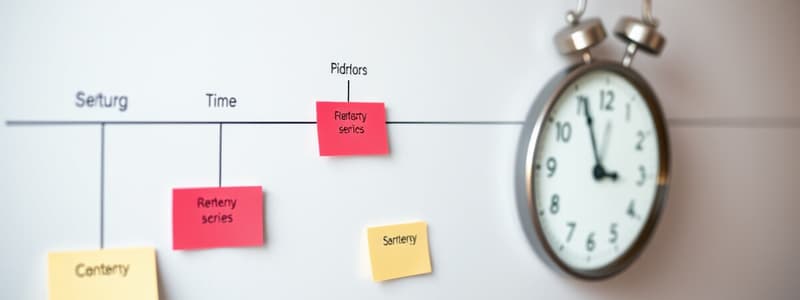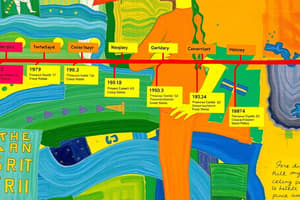Podcast
Questions and Answers
What is the primary benefit of using a chronological arrangement for tasks?
What is the primary benefit of using a chronological arrangement for tasks?
- Allows for multitasking across different tasks
- Reduces the need for setting deadlines
- Enables random organization of tasks without structure
- Helps prioritize tasks based on urgency and importance (correct)
Which technique is most suitable for visually representing tasks along a timeline?
Which technique is most suitable for visually representing tasks along a timeline?
- Gantt Charts (correct)
- Calendar Scheduling
- To-Do Lists
- Time Blocking
What is a common challenge associated with time management?
What is a common challenge associated with time management?
- Procrastination (correct)
- Using a well-structured schedule
- Effective use of digital apps
- Setting too few deadlines
Which step is NOT part of effective time management strategies?
Which step is NOT part of effective time management strategies?
Which tool is commonly used to enhance focus and productivity through structured intervals?
Which tool is commonly used to enhance focus and productivity through structured intervals?
Study Notes
Chronological Arrangement: Time Management
-
Definition of Chronological Arrangement
- Organizing events or tasks in the order they occur over time.
- Useful for planning, tracking progress, and ensuring deadlines are met.
-
Importance of Time Management
- Enhances productivity and efficiency.
- Reduces stress by providing a clear structure.
- Helps prioritize tasks based on urgency and importance.
-
Techniques for Chronological Arrangement
- To-Do Lists:
- List tasks in the order of deadlines or priority.
- Calendars:
- Use digital or physical calendars to schedule tasks and events.
- Gantt Charts:
- Visual representations of tasks along a timeline, showing start and end dates.
- Time Blocking:
- Allocate specific time periods for particular tasks.
- To-Do Lists:
-
Steps for Effective Time Management
- Set Clear Goals: Define short-term and long-term objectives.
- Prioritize Tasks: Use methods like the Eisenhower Box to distinguish between urgent and important tasks.
- Create a Schedule: Develop a daily or weekly plan that includes all tasks in chronological order.
- Review & Adjust: Regularly assess progress and adjust plans as necessary.
-
Tools for Time Management
- Digital Apps: Tools like Trello, Asana, or Todoist for task management.
- Pomodoro Technique: Work in short bursts with breaks in between to enhance focus and productivity.
- Reminder Systems: Use alarms or notifications to stay on track with deadlines.
-
Common Challenges
- Procrastination: Delaying tasks can disrupt chronological order.
- Overcommitment: Taking on too many tasks can lead to mismanagement of time.
- Distractions: External factors can hinder the ability to stick to a schedule.
-
Best Practices
- Break larger tasks into smaller, manageable parts for better tracking.
- Set realistic deadlines to maintain motivation and avoid burnout.
- Regularly reflect on time usage to identify areas for improvement.
Chronological Arrangement: Time Management
- Chronological arrangement involves organizing events or tasks by the sequence they occur over time, facilitating effective planning and progress tracking.
- Effective time management significantly boosts productivity and efficiency and reduces stress by establishing a clear structure for tasks.
- Prioritizing tasks based on urgency and importance is crucial for effective time management.
Techniques for Chronological Arrangement
- To-Do Lists: Organize tasks according to deadlines or priority levels for clear visibility on upcoming responsibilities.
- Calendars: Utilize digital or physical planners to schedule and manage tasks and events, enhancing time visibility.
- Gantt Charts: Provide a visual timeline of tasks with explicit start and end dates, helping with project management.
- Time Blocking: Allocate specific periods for particular tasks to maintain focus and structure daily activities.
Steps for Effective Time Management
- Set Clear Goals: Establish both short-term and long-term objectives to guide daily activities.
- Prioritize Tasks: Distinguish between urgent and important tasks using frameworks such as the Eisenhower Box for better focus.
- Create a Schedule: Develop a chronological daily or weekly plan including all tasks to ensure efficient time allocation.
- Review & Adjust: Regularly assess progress and adapt plans to improve efficiency.
Tools for Time Management
- Digital Apps: Use applications like Trello, Asana, or Todoist for streamlined task management and project tracking.
- Pomodoro Technique: Implement working in short bursts followed by breaks to enhance concentration and prevent burnout.
- Reminder Systems: Set alarms or notifications to keep track of deadlines and maintain schedule adherence.
Common Challenges
- Procrastination: Delaying tasks disrupts the established chronological order, negatively impacting productivity.
- Overcommitment: Taking on too many responsibilities can lead to time mismanagement and overwhelm.
- Distractions: External interruptions hinder the ability to maintain focus and follow the planned schedule.
Best Practices
- Break down larger tasks into smaller, manageable pieces to facilitate progress tracking and reduce overwhelm.
- Set realistic deadlines to sustain motivation and prevent burnout from excessive pressure.
- Regularly reflect on time usage to identify inefficiencies and areas requiring improvement for better time management.
Studying That Suits You
Use AI to generate personalized quizzes and flashcards to suit your learning preferences.
Description
Test your knowledge on chronological arrangement and time management techniques. This quiz covers definitions, importance, and effective strategies for managing time efficiently. Enhance your understanding of productivity and prioritization.




